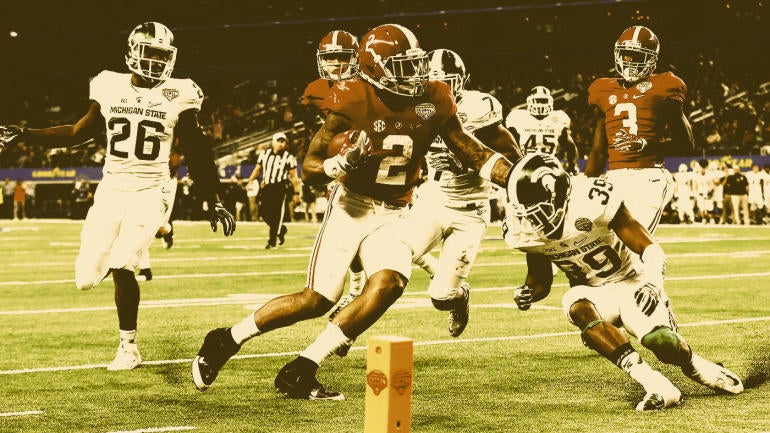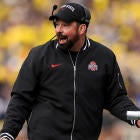
Brian Kelly shrugged. The response from the Notre Dame coach came to one of the great cosmic questions of the modern college football universe.
Why have College Football Playoff games, in general, not been close?
The playoff has spewed a gusher of cash and made for some needless hand-wringing each Tuesday night of the CFP Rankings shows, but the games as a whole have been less than compelling.
Eight of the previous 12 semifinal games have been decided by at least 17 points. The average margin of victory in those games is more than three touchdowns (21.25). The 18 playoff games -- semifinals and national championship combined -- have seen victory margins of nearly 19 points.
BK, you have the floor for an explanation.
"I really couldn't tell you," said Kelly.
If you were marketing the CFP right now, it might be a tough sell. Television ratings for the CFP are down. Only six teams have won a game in the six years of the event. Only four have won at least two. Three of those are in this playoff -- Alabama, Clemson and Ohio State. Even then, the Buckeyes have gone winless (0-2) in the CFP since taking the first championship in 2014.
Fortunately (or unfortunately), a four-team playoff is locked in for another six years per ESPN's contract with the CFP.
"I thought they should have canceled the bowl games and expanded the playoff to eight teams," one FBS coach told CBS Sports. "This would have been a perfect year to do that."
But here we are going into Year 7 of the CFP with the past humiliations having become only slightly less entertaining than the past champions. This season's semifinals -- No. 1 Alabama vs. No. 4 Notre Dame and No. 2 Clemson vs. No. 3 Ohio State – feature teams that are among the best at being the best. The four have accounted for five of the six CFP National Championships.
Since the first year of the playoff in 2014, those four are also first (Clemson), second (Alabama), 10th (Ohio State) and 19th (Notre Dame) at covering the spread nationally. That indicates some sort of numbing consistency, but it doesn't accurately reflect each program's share of embarrassment in the CFP era.
Clemson owns a loss of 17 (in last January's title game to LSU). Alabama was taken out by Clemson in the 2019 title game by 28. A 31-0 semifinal loss to Clemson in 2017 caused Ohio State's Urban Meyer to retool his offensive staff.
Part of that turnover included hiring the San Francisco 49ers quarterbacks coach to the same position at Ohio State. Four years later, Ryan Day is 22-1 as a head coach. Kevin Wilson was brought in as offensive coordinator after resigning as coach at Indiana. If that blowout doesn't happen, maybe Day isn't at Ohio State having kept Wilson as his OC when Meyer retired. Both are in their second straight playoff.
"Sometimes, I wake up and just have to pinch myself a little bit," Day said. "It wasn't that long ago that who would ever have thought in being in a situation like this."
| Playoff team | 2020 victory margin | Category rank |
|---|---|---|
(1) Alabama | 30.27 points | 1 |
(2) Clemson | 27.36 points | 3 |
(3) Ohio State | 21.50 points | 6 |
(4) Notre Dame | 16.54 points | 10 |
That's not to ignore the CFP's stunning finishes. Clemson's game-winning touchdown with one second to go in the 2017 championship against Alabama might be the program's No. 1 moment. Georgia rallied back from 17 down in the 2018 Rose Bowl semifinal to beat Oklahoma in double overtime.
"It's a game of a few plays. It's a game of momentum," Clemson coach Dabo Swinney said. "In those type of games, momentum is a huge, huge thing, and sometimes games can get away."
Notre Dame is still trying to live down a 30-3 loss to Clemson two years ago in the CFP semifinal. That combined with a 42-0 whipping by Alabama in the 2013 BCS Championship Game has labeled the fourth-seeded Fighting Irish as the team most likely to be blown out this time.
The 19.5-point spread favoring the Crimson Tide is the largest in CFP history.
"We're knocking at the door every year," Kelly said. "There's elite football teams. I don't know why this narrative continues to pop up when we're always in the games. No, we haven't won a national championship [with me as coach], that's correct. I'm not changing the record. But we are there every single year and we are grinding out like everyone else. Only one team gets to celebrate at the end of the year."
Other playoff indignities:
- The Pac-12 hasn't had a sniff of the CFP since a 17-point semifinal loss to Alabama four years ago.
- The Big 12 remains the only Power Five league without a playoff win having been outscored by a combined 72 points in four semifinal losses (all by Oklahoma).
- A No. 1 seed was won it all only once, which suggests some sort of parity. But that No. 1 was LSU last year, which ran through two playoff games outscoring opponents by a combined 52 points in arguably the most dominant season ever.
- There have been only six point-spread upsets out of 18 total CFP games. Three of those six have come in national championships. One of those six hardly counts as Ohio State was a mere 1-point favorite before losing to Clemson in the 2017 Fiesta Bowl.
- The argument can be made the CFP has been less enthralling than the system it replaced. The 16 BCS Championship Games were decided by an average of 14.6 points. Six of 16 were one-score games. Only five of 18 CFP games have been decided by a touchdown or less.
- The 18 CFP games have been decided by an average of 18.72 points. That's more than the average victory margin for all games in 2020, which was 17.3 points, according to Pro Football Focus.
"It's not like the NFL where 70% of the games are decided by a touchdown or less," Alabama coach Nick Saban said. "It seems that, in college football, the teams that can score points usually fare well in games like this. You've got to be able to play good defense to try to keep from getting beat before you can win."
It may be as simple as Alabama and Clemson flexing on everyone these last seven years. If the Power Five has separated itself from the Group of Five, the Tide and Tigers have separated themselves from everyone else. Alabama and Clemson are 1-2 in winning percentage over the last decade. No slouch, Ohio State is third. Oh yeah, and Notre Dame is the fifth-winningest program of all time.
Certainly the Irish are better than that semifinal loss two years ago. But they face what might be the most dominant Tide team of the Saban era. The six Alabama AP All-America selections were more than Clemson, Ohio State and Notre Dame had combined (five).
"The great thing about the playoffs … is that by that time you're now trading wits with people that are just as talented on the field," said veteran coach Terry Bowden, who is currently transitioning from a Clemson analyst role to become the new coach at Louisiana-Monroe. "If you're not at your best … it'll show up and it'll show up big."
One staffer at Clemson stressed the importance of self scouting. In other words: Are we really good as we think we are?
"You're favored by 20 or more points every game," he said. "Did we do a good job, or are we that much better? … When you get to a huge game, that shows whether you have any scars or weaknesses. "
Another consideration: These all bright, glittering brand names. But is it all getting too repetitive?
"CFP -- or shall we say the Power Five Invitational -- doesn't help itself when you can count on one hand the number of teams in August that will be vying for the four spots in January," one TV executive said.
The TV ratings reflect that opinion. From 2014-18, ratings for the CFP declined more than 25%, according to Sports Media Watch. (The numbers were up slightly in 2019.)
The 2006 BCS Championship Game between Texas and USC remains the highest-rated national championship since 1998. The first CFP National Championship in 2015 (Oregon-Ohio State) is second.
Current rightsholder ESPN has been feeling the financial pinch losing cable subscribers as more consumers cord cut and go to streaming platforms. The COVID-19 pandemic isn't likely to boost those numbers in 2020.
Consider those six teams that have won at least one CFP game -- Alabama, Clemson, Georgia, LSU, Ohio State and Oregon. That would suggest the playoff, like the BCS before it, is dominated by the SEC. That's good for the SEC, bad for variety.
"There are have been some crummy uncompetitive games played in the CFP era thus far," that TV executive said.
One simple reason: The best teams continue to be very good at winning -- big. Since 2014, Alabama, Ohio State and Clemson are 1-2-3 in average victory margin. Notre Dame is tied for 12th. No surprise, then, that for the first time there are no newcomers to the playoff. They've all been here before.
On the surface, the blowout nature of the CFP would argue against expansion. More (and probably lesser) teams aren't going to make the CFP more competitive. But for some, anything is better than watching Alabama and Clemson again. If both win their semifinal games, they would meet for the fifth time in the seven years of the playoff.
Are things more interesting if Cincinnati and Texas A&M are in the mix this year?
"My concern was as soon as we started to have playoffs all the focus would be on the teams on the playoff, and there would be a minimal amount of interest in some of the other games," Saban said. "Most of the emphasis is on the playoffs. In some ways, that's unfair to the other teams. I don't know what the solution is. I know this is the system that we have."





















